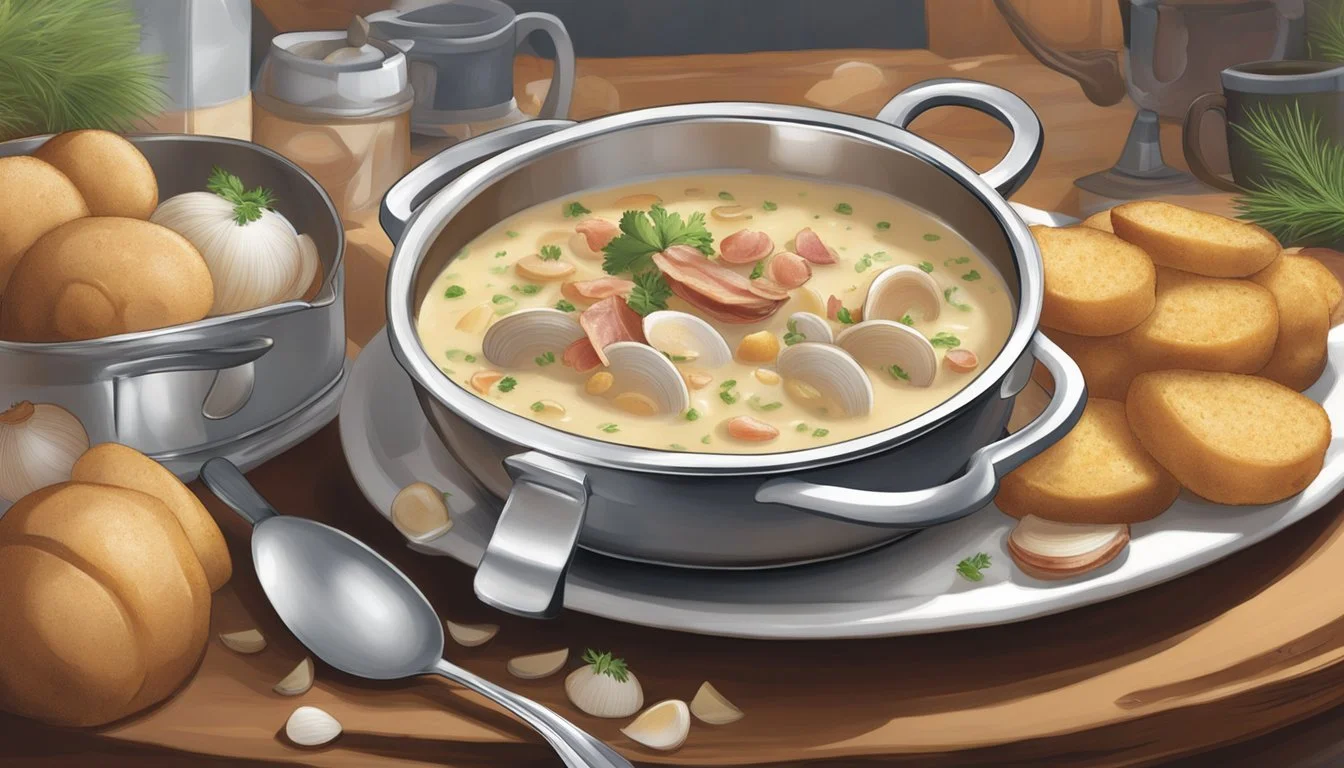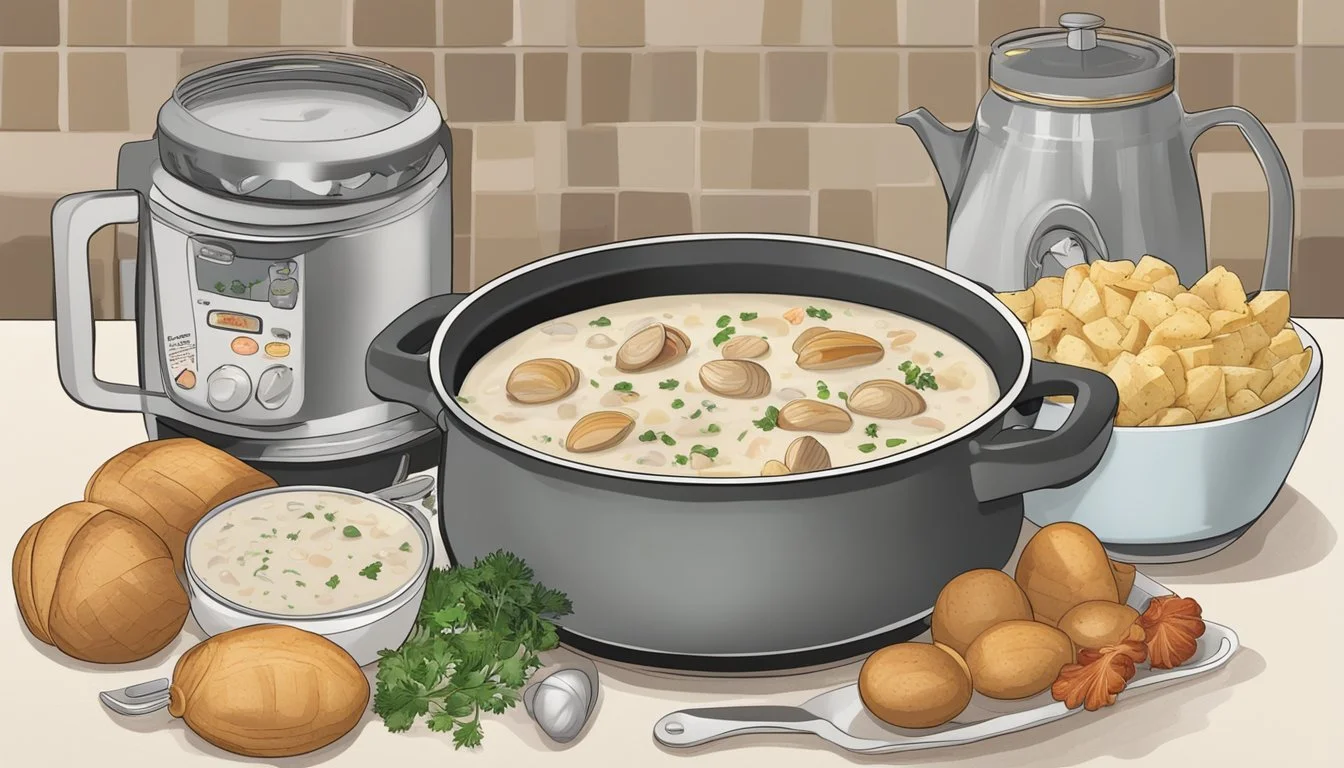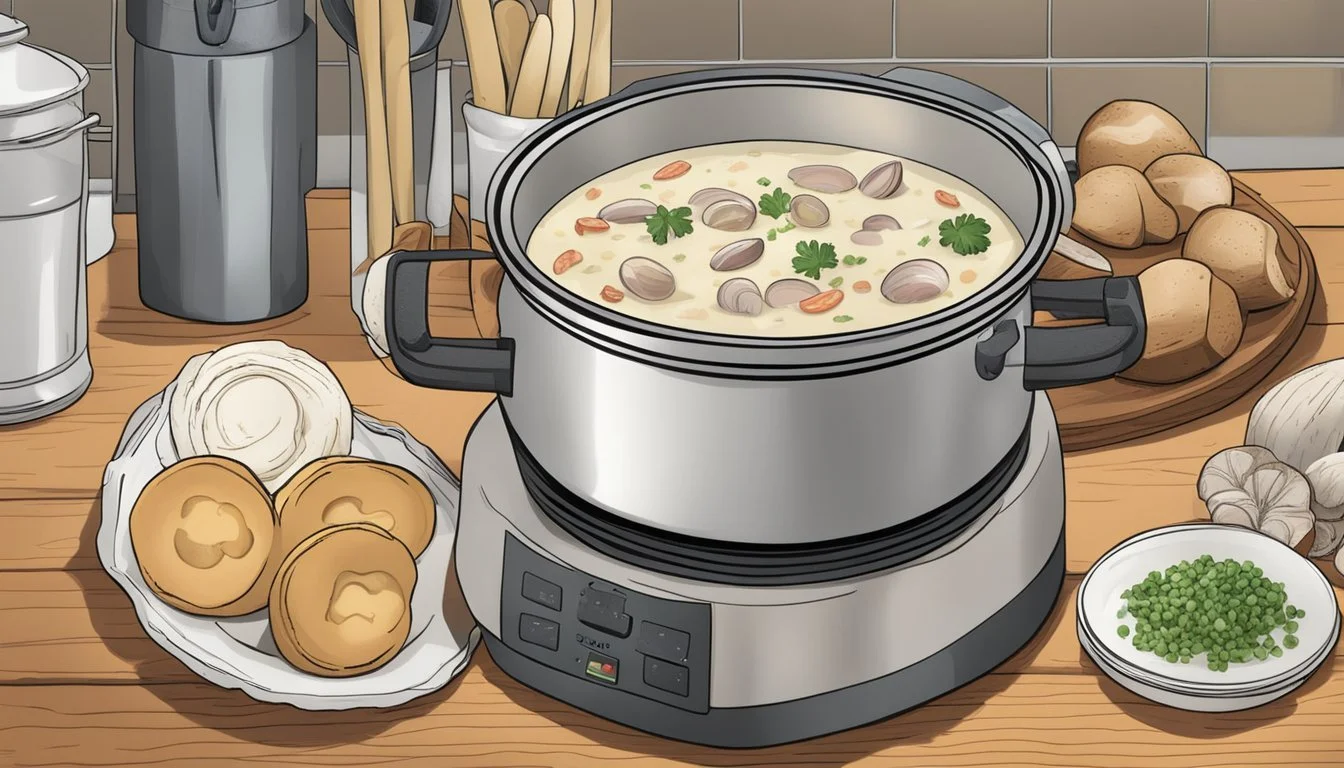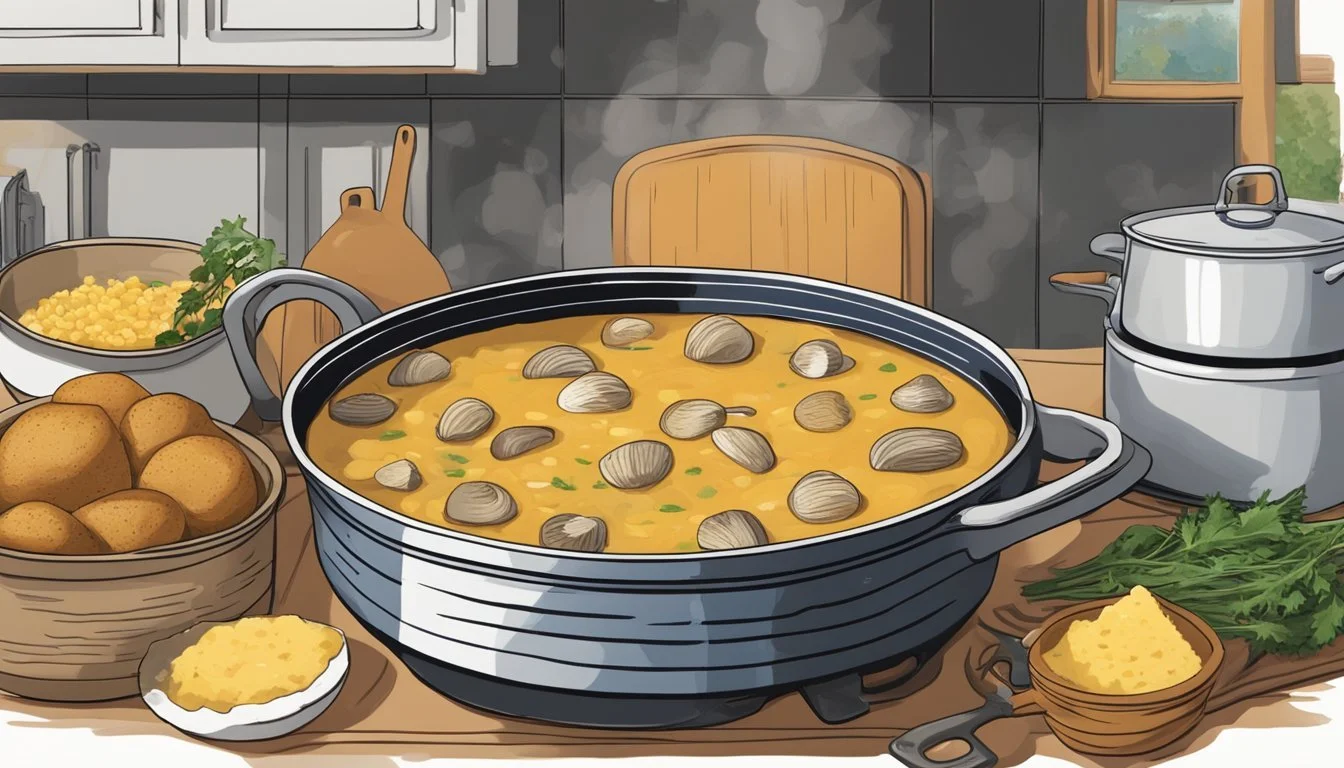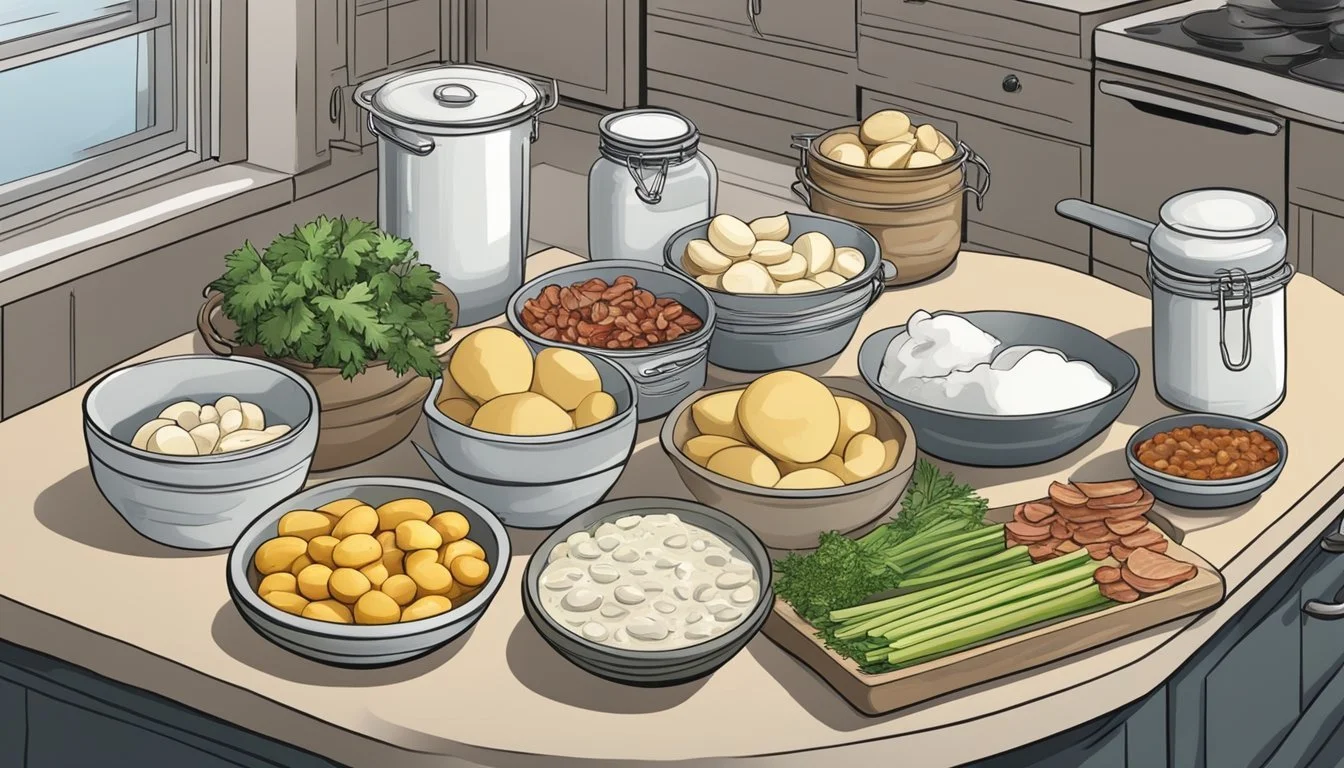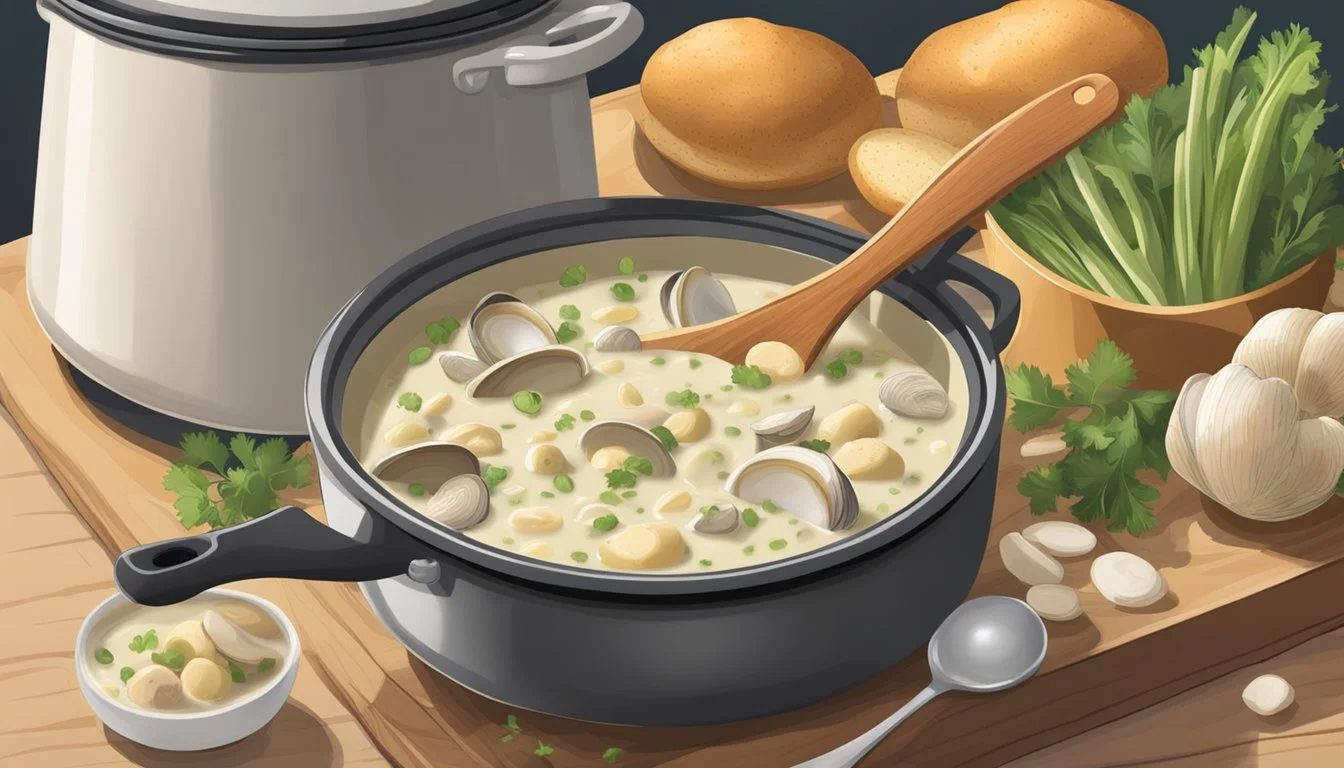How to Prepare a Texas-Style Clam Chowder
A Step-by-Step Guide
Clam chowder, a beloved comfort food, takes on a unique twist in Texas, where the flavors are as bold as the state itself. Texas-style clam chowder deviates from the traditional New England variety by incorporating ingredients such as fresh parsley and sometimes a splash of white wine, infusing the creamy soup with a distinct taste that keeps the palate intrigued. As seafood (What wine goes well with seafood?) lovers might expect, the foundation of any noteworthy chowder lies in the quality of its clams (What wine goes well with clams?), insisting on the freshest catch and ensuring they are meticulously cleaned to rid them of sand and grit.
In the preparation of Texas-style clam chowder, patience with the cooking process is essential as it allows the varied components to meld together harmoniously. The base typically starts with a roux, a simple yet crucial blend of flour and butter, which is necessary to achieve the thick, rich texture that chowder enthusiasts adore. Milk, often combined with clam juice, serves as the creamy backdrop for the potatoes and vegetables, becoming the medium that carries the gentle yet assertive flavors expected from a dish with such a strong regional identity.
The contemplation of every ingredient is key in creating a chowder that resonates with authenticity and depth. With the inclusion of each element, from the careful simmering of vegetables until tender to the final addition of clams, there's a deep respect for the traditional methods of chowder-making tempered by the individuality of Texan cuisine. The result is a comforting bowl of clam chowder that stands commendable in its balance between the classic and the contemporary.
History and Regional Variations
Clam chowder has a deep-rooted place in American food culture, with New England being the icon of this tradition. As the dish traveled, it embraced local influences, culminating in unique variations like the Texas-style clam chowder where regional tastes tailor the classic recipe.
New England Influence
Historically, New England clam chowder stands as a comforting staple in the northeastern United States, tracing its lineage back to the 1700s. It is characterized by a hearty ensemble of clams, diced potatoes, onions, and occasionally salt pork, simmering in a creamy milk or cream base. The prominence of clams in this dish showcases the New England region's rich maritime heritage and has been a warm embrace against the coastal chill for centuries.
Texas Twist on Traditional Clam Chowder
As the dish ventured into Texas, chefs infused the conventional chowder with bold local flavors, giving rise to the Texas-style clam chowder. This variation keeps the clams as a centerpiece but introduces a piquant layer with the addition of ingredients like roasted jalapeños, diced tomatoes, and a splash of hot sauce. Texans favor the clam chowder that packs a punch, aligning with the state's love for hearty, flavorful dishes.
Essential Ingredients
Crafting an authentic Texas-style clam chowder necessitates a harmony of quality clams and robust flavors. Each ingredient serves a specific purpose, contributing to the chowder's trademark hearty texture and rich taste.
Selecting Clams
For the chowder's foundation, fresh clams are paramount. Chopped clams are most commonly used, with freshness indicated by shells that close when tapped. Clams should feel light, signifying an absence of undesired sand or mud. It is recommended to cleanse them in a brine solution if they appear overly gritty.
Clams: Look for fresh, light shells that close when tapped.
Preparation: Rinse under cold water, or soak in brine if needed.
Vegetables and Aromatics
A mixture of vegetables and aromatics adds depth to the chowder. Onions and garlic provide a fragrant base, best sautéed in butter for a sweeter profile. Carrots and celery (how long does celery last?) further enhance the broth, while russet potatoes contribute a starchy thickness.
Onions and Garlic: Sautéed in butter until tender.
Potatoes: Russet potatoes are preferred for their starchy quality.
Additional Vegetables: Carrots and celery, diced.
Meats and Alternatives
While rendered bacon (how long does bacon last?) imparts a smoky dimension to the chowder, it can be substituted with alternatives for those seeking non-pork options. Meat alternatives should still aim to provide a savory quality akin to bacon's contribution.
Bacon: Rendered and added for smoky depth.
Alternatives: Seek savory non-pork options if necessary.
Cooking Techniques
In Texas-style clam chowder, cooking techniques are pivotal for creating rich flavors and achieving the desired consistency.
Building Flavor Layers
The foundation of any good chowder lies in effectively layering flavors. One begins by sauteing vegetables like potatoes, onions, and celery until they soften. This process helps to release their natural sugars and creates a subtle sweetness in the base. After this, additional flavor is built by cooking flour with the vegetables for a brief period. It is then crucial to slowly incorporate the liquids, typically clam juice and stock, stirring steadily to meld the flavors.
Thickening the Chowder
Achieving the right thickness in chowder is essential. To thicken the mixture, flour is used as a roux. The process involves:
Cooking the flour with butter or other fats over medium heat until smooth, to ensure that there is no raw flour taste.
Gradually whisking in the liquids—milk, vegetable stock, and clam juice—to avoid lumps.
Bringing the chowder to a simmer. The heat allows the starch in the flour to expand and thicken the soup.
It should be noted that one should simmer the chowder until the potatoes are tender and the soup reaches a creamy consistency. This part of the cooking process typically takes about 12-15 minutes.
Seasonings and Spices
When preparing a Texas-Style Clam Chowder, the choice of seasonings and spices is crucial to achieving that hearty, robust flavor. Attention to the balance of spices and the adjustment of saltiness will elevate the chowder to culinary excellence.
Herbs and Spices
In a Texas-Style Clam Chowder, spices do more than add heat; they impart depth and character. A foundational spice is paprika; its smoky undertones resonate well with the clams. Old Bay Seasoning is a quintessential addition, with its blend of celery salt, black pepper, and paprika bringing a savory, slightly spicy edge to the dish. For an authentic Texas kick, a pinch of cayenne pepper can be included.
Incorporating fresh herbs like cilantro lends a bright, aromatic contrast to the creamy chowder. Cilantro should be added towards the end of cooking to preserve its delicate flavor. One should start with a small handful of chopped cilantro and then adjust according to taste.
Adjusting Saltiness to Taste
Salt is an essential seasoning in any chowder, but its presence should complement, not overpower. To adjust the saltiness, first consider the inherent salt in the ingredients like clam juice and bacon. It’s advisable to taste as one goes along and then add salt, if necessary, in small increments. The suggestion is to use kosher salt for its ability to disperse more evenly throughout the dish.
Concisely, the spices should harmonize with the fresh cilantro to create a richly flavored chowder, while saltiness is carefully controlled to accentuate these flavors.
Accompaniments and Garnishes
When serving Texas-style clam chowder, the right accompaniments and garnishes can enhance the flavors and textures. Choosing the ideal sides and toppings will balance the hearty soup with crisp, fresh, and tangy elements.
Traditional Sides
Traditional sides for clam chowder often include bread for dipping and adding texture. A popular choice is sourdough bread, which provides a robust, tangy flavor that complements the richness of the chowder. Another common side is crackers, ideally oyster or saltine crackers; they offer a salty crunch that pairs well with the creamy texture of the soup.
Sourdough Bread: Offers a tangy contrast to the creamy soup.
Crackers:
Oyster Crackers: Small, crunchy, and ideal for floating on top.
Saltine Crackers: Classic choice for a salty crunch.
Innovative Garnishes
Innovative garnishes can elevate Texas-style clam chowder from a simple dish to a more complex and visually appealing one. Sprinkling cheddar cheese on top adds a sharp, cheesy tang and creamy melt that can enrich every spoonful. A squeeze of lemon juice before serving introduces a bright, citrusy note to cut through the richness and refresh the palate.
Cheddar Cheese: Adds a sharp, indulgent layer when melted.
Lemon: A wedge for squeezing adds a burst of citrus to brighten the chowder.
Serving Suggestions
When serving Texas-Style Clam Chowder, the accompanying dishes can enhance the meal whether it's for breakfast, lunch, dinner, or brunch (What wine goes well with brunch?). Remarkably versatile, this chowder can be presented with a range of sides to elevate the dining experience. Below are confident and knowledgeable suggestions to consider:
Seafood Enhancements
Mussels (What wine goes well with mussels?) are an excellent complement, lending a luxurious touch to the chowder when served in a simple white wine broth.
A shrimp salad with avocado and lime pairs beautifully, with the citrus notes accentuating the chowder's richness.
For a Lighter Touch
Brunch: Offer a fresh avocado toast topped with poached eggs, balancing the chowder's heartiness with crispness.
Appetizer: A small serving of clam chowder can pave the way for a seafood-centric meal.
Heartier Complements
Dinner rolls or oyster crackers can be served alongside, perfect for dipping and sopping up the flavorful broth.
A side of roasted potatoes or cornbread makes for a fulfilling addition, especially for dinner serving.
Time of Day Pairings
Breakfast: Although unconventional, pairing the chowder with a simple fried egg can start the day with a satisfying option.
Lunch: Accompany with a light Caesar or garden salad to balance the midday meal.
Here is a suggestion table to summarize and clarify the options:
Meal Time Suggestion Breakfast Fried egg, Avocado Toast Lunch Caesar Salad, Garden Salad Dinner Roasted Potatoes, Dinner Rolls Brunch Shrimp Salad Avocado, Mussels in Broth
Craft each meal with one or more of these sides to experience the full potential that Texas-Style Clam Chowder has to offer.
Nutritional Information
Clam chowder is a hearty soup that can vary widely in its nutritional content based on the recipe used. A traditional Texas-style clam chowder may include bold flavors and ingredients like smoked bacon or jalapeños, on top of the usual clams, potatoes, onions, and a cream base.
Calories: A typical serving of clam chowder can contain between 200 to 400 calories. The inclusion of cream and bacon in Texas-style chowder can increase the caloric count, especially if larger serving sizes are consumed.
Dietary Fiber: The vegetables such as onions and potatoes contribute dietary fiber to the soup. Fiber is crucial for digestive health. A single serving may offer 1 to 4 grams of fiber, depending on the amount of vegetables used.
Proteins: Clams are an excellent source of lean protein. A one-cup serving might offer about 16 grams of protein, which contributes to muscle repair and growth.
Fats: Texas-style clam chowder can be higher in fats due to the use of bacon and cream. These fats can increase the richness and flavor profile of the soup. Unsaturated fats from the clams contribute to a healthy diet, but saturated fats from bacon and heavy cream should be consumed in moderation.
Sodium: One should be mindful of the sodium content in clam chowder. It may contain upwards of 600-800 milligrams per cup mainly due to the natural salt in clams and added salt in the seasoning.
Dietary Considerations: To reduce calorie and fat intake, substitutes such as low-fat milk or turkey bacon can be used. Those monitoring their sodium intake should opt for low-sodium broth and limit added salt.
In summary, while Texas-style clam chowder can be a rich and flavorful dish, it is important to take its high sodium and fat content into consideration when including it in a balanced diet.
Pairing with Beverages
When preparing a Texas-style clam chowder, the choice of beverage is crucial to complement the flavors of the dish. This American cuisine classic pairs well with a variety of drinks, both alcoholic and non-alcoholic.
Wines:
White Wine: A dry Chardonnay or Sauvignon Blanc matches well with the creamy texture and the seafood flavor of the chowder.
Sparkling Wine: A glass of Prosecco or Champagne brings out the richness of the chowder with its crisp acidity.
Beers:
Pale Ale: The hoppy notes cut through the creaminess.
Pilsner: This beer complements the chowder with its clean and refreshing taste.
Non-Alcoholic Options:
Iced Tea: Sweet or unsweetened, iced tea is a refreshing choice.
Lemonade: Its citrus tang contrasts nicely with the chowder's creamy base.
Beverage Type Recommended Option Notes Wine Chardonnay, Sauvignon Blanc Dry wines counterbalance the creaminess. Sparkling Wine Prosecco, Champagne Effervescence cleanses the palate. Beer Pale Ale, Pilsner Hoppy or clean flavors work well with the soup. Non-Alcoholic Iced Tea, Lemonade Choose for a refreshing contrast to the rich chowder.
When selecting beverages to serve with Texas-style clam chowder, it's important to consider the balance of flavors. Beverages should enhance the dining experience without overpowering the dish's nuanced flavors. Whether one prefers the complexity of a fine wine, the casual refreshment of beer, or the simple pleasure of a non-alcoholic drink, the right pairing can elevate the meal.
Tips for Home Cooks
When preparing a Texas-style clam chowder, home cooks should focus on selection and preparation of ingredients to ensure a flavorful and authentic dish.
Choosing Ingredients:
Clams: Fresh clams are preferred for their briny flavor. They should be thoroughly cleaned to remove sand or debris.
Clam Juice: Retain the clam water when cooking clams. If needed, supplement with bottled clam juice for a robust base.
Potatoes: Choose potatoes that hold their shape when cooked, like Yukon gold or red potatoes.
Preparation Techniques:
Cleaning Clams: One must clean the clams carefully to ensure grit-free chowder. Scrub each clam under cold running water and soak in fresh water to release any sand.
Roux: A roux—flour cooked in butter—serves as a thickener. One should cook it until lightly browned but not burnt.
Vegetables: Sautéing onions and other vegetables before adding them to the chowder can enhance their flavors.
Cooking Steps Details Sauté Vegetables Fry onions until translucent to form flavor base Thicken with Roux A roux ensures a rich, creamy texture Simmer Potatoes Cook until just tender for perfect consistency Clam Water/Juice Combination Use 2 cups for a balanced clam flavor
For authentic Texas-style flavor, consider incorporating local spices or a dash of hot sauce for heat. Cooks should focus on the harmony of flavors, balancing the savory clams with the creamy base. The chowder should be simmered until the potatoes are tender, ensuring all the ingredients meld together harmoniously.
Scaling for Events
When preparing Texas-style clam chowder for events, planners must consider the size of their audience. For large gatherings, the recipe should be adjusted to accommodate the number of guests.
Ingredients Scaling: Ingredients should be multiplied according to the number of servings required. A helpful table indicates the adjustments needed for different group sizes:
Servings Clams (lbs) Potatoes (lbs) Onions (cups) White Wine (cups) 10 2 1.5 0.5 1 50 10 7.5 2.5 5 100 20 15 5 10
Preparation Stations: To maintain efficiency, divide the cooking process into multiple stations. One station can handle vegetable prep, another can manage the sautéing process, while a third can be responsible for the assembly and simmering of the chowder.
Catering to Preferences: Not all guests may consume alcohol present in white wine. It's advisable to have an alternative such as clam juice or broth to cater to all preferences.
Social Media Engagement: Engage attendees by showcasing the preparation on social media platforms. A live cooking demonstration can create buzz and drive membership for aspiring cooks interested in learning about regional cuisine.
Business Considerations: For catering businesses, it is important to factor in the cost of ingredients at scale, ensuring that the price per serving aligns with the overall event budget. Providing a memorable culinary experience can lead to recurring business and positive referrals.
Cultural Significance in American Cuisine
Clam chowder, a dish with deep roots in American food culture, is a testament to the melting pot that is the United States. Each region, from the brisk shores of New England to the sun-soaked coast of California, has tailored this classic soup to reflect its local flavors and culinary traditions.
New England Clam Chowder stands out with its creamy consistency and usage of local quahog shellfish, becoming an emblem of the region. Its prevalence speaks to the historical significance of seafood in these northern states. Moving southward, Louisiana's rich culinary tapestry has spiced up traditional chowder recipes incorporating the kick of Creole and Cajun influences, indicative of New Orleans' vibrant food scene.
On the opposite coast, California cuisine often puts a lighter, health-conscious spin on clam chowder, aligning with the state's fresh produce and dietary trends. San Francisco's adaption, often served in a sourdough bread bowl, showcases this fusion of local taste and culinary innovation.
Within the American South, and especially Texas, clam chowder isn't traditionally a staple like it is in New England. However, innovative chefs in cities like Austin, with their flair for integrating local flavors, have crafted versions of clam chowder that marry the southern love for bold tastes with the classic chowder foundation.
New York stands its ground with Manhattan Clam Chowder, a tomato-based variant that is a departure from the cream-based versions, reflecting the state's diversity in its culinary preferences.
The importance of clam chowder in American cuisine is not just about the soup itself, but what it represents — regional diversity, local ingredients, and the adaptability of American cooking styles. It exemplifies how a single dish can tell a myriad of stories across one country.
Food Safety and Storage
When preparing Texas-style clam chowder, storing ingredients properly is crucial for safety. Fresh clams should be stored in the refrigerator at temperatures below 40°F and used within two days. Clams must be alive before cooking; their shells should close when tapped. If they do not, discard them.
For the chowder, proper cooling is essential. Divide the chowder into shallow containers to reduce cooling time and prevent bacterial growth. Refrigerate the chowder within two hours of cooking. It can be stored in the refrigerator for up to three days.
Clam Storage:
Keep clams in a mesh bag or open container.
Cover with a damp cloth to maintain moisture.
Store in the coldest part of the refrigerator.
Chowder Storage:
Cool quickly and refrigerate in a covered container.
Consume within three days.
Reheating:
Reheat chowder to at least 165°F.
Stir regularly for even heating.
Always wash hands before handling ingredients and ensure utensils and cooking surfaces are clean to avoid cross-contamination. If the chowder or any seafood smells off or has an unusual texture, it should be discarded to prevent foodborne illness.
Related Dishes and Variations
While Texas-style clam chowder is a hearty favorite, similar comfort dishes from across the United States captivate with their unique regional flavors. Notably, New York City is home to Manhattan clam chowder, which distinguishes itself with a tomato-based broth, imparting a zestier flavor profile.
San Francisco, on the other hand, is known for its iconic sourdough bread clam chowder, treating diners to a creamy chowder served in a hollowed-out sourdough loaf, inviting a delightful textural contrast.
From the Southeast, Charleston is revered for its gumbo, a Southern classic. Gumbo often incorporates okra, a vegetable that contributes a signature texture and taste. This stew also typically features a variety of seafood and meats, resembling a tantalizing fusion of flavors and textures akin to a diverse chowder.
Heading up the coast, Philadelphia claims fame for its seafood offerings, with dishes like creamy seafood chowders that celebrate regional catches. In addition, the city's culturally rich food scene includes empanadas—a testament to its culinary diversity—which, while not a chowder, share the comforting, hand-held appeal.
New York City: Manhattan Clam Chowder
San Francisco: Sourdough Clam Chowder
Charleston: Seafood Gumbo
Philadelphia: Seafood Chowder, Seafood Empanadas
Additionally, the lobster (What wine goes well with lobster?) roll, a New England staple, represents a different approach to enjoying similar seafood flavors found in clam chowder, offering a chilled, mayonnaise-dressed alternative served in a soft, buttery roll.
In summary, the American culinary scene offers a mosaic of related dishes and variations, each imparting its own storied taste and character, inspired by the local culture and ingredients.
Conclusion
A Texas-Style Clam Chowder presents a culinary adventure blending the ocean's bounty with the heartiness of Southern cuisine. The chowder's richness is amplified by the careful selection and preparation of its clams. One must ensure that these are devoid of sand and grit, assisting in delivering a clean, robust flavor. The procedure elucidates the importance of freshness in both clams and vegetables alike.
Method Highlights:
Clams should be cleaned and kept on ice until needed to guarantee succulence.
Aromatic vegetables enhance the chowder's complexity.
The white wine works its magic in the base, subtly infusing depth.
Pointers for an optimal Texas-Style Clam Chowder include the use of a dry white wine and fresh parsley—elements that maintain the dish's authentic zest. A proper roux, thickened with milk and half-and-half, ensures the chowder's requisite creaminess without overwhelming the palate.
Recipe Keys:
Cooking clams just until they open preserves their tender texture.
Integration of a well-cooked roux avoids flour clumps.
Distinct from its New England counterpart, this Southern rendition holds its own with assertive seasoning and distinctive textures. The chowder satisfies heartily without resorting to excess—hearty vegetables and quality clams speak for themselves.
In essence, they concoct a balanced, mouthwatering stew, sure to be the centerpiece at any dining table. Its wholesomeness is owed to quality ingredients, merged with respect for the chowder tradition tailored to Texas tastes.

